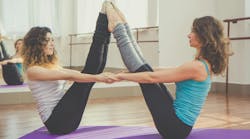Wellness Corner: The posture reconnection for dental clinicians
What you’ll learn in this article
- How poor posture during dental procedures contributes to musculoskeletal disorders and impacts clinical performance
- What ergonomic adjustments—like chair height, patient positioning, and instrument layout—can reduce strain and support healthier posture
- Which stretches to incorporate between patients to relieve muscle tension and improve mobility
- Why building foundational strength through resistance exercises is essential for sustaining good posture in daily practice
It’s commonly accepted that humans in 2025 have poorer posture than those just a few decades ago. Electronic device usage, sitting jobs, sedentary lifestyles, and, in our case, our profession has greatly contributed to this poor posture.1 Dentistry is a demanding profession requiring sustained focus, fine motor skills, and close proximity to patients. Over time, these demands often lead clinicians to adopt poor postural habits such as slouching over patients, hunching the now internally rotated shoulders, and craning the neck. While these positions may seem harmless in the moment, research shows that chronically poor posture contributes to musculoskeletal disorders (MSDs) and pain. Fortunately, evidence-based strategies can help optimize our ergonomics and protect our health.
The impact of poor posture
Prolonged static postures and awkward positions are among the most significant occupational hazards in dentistry. One study showed that up to 91% of dental professionals report work-related MSDs, with the back, shoulders, and neck being the most frequently affected regions.2 Slouching or forward head posture increases strain on the cervical spine and shoulder girdle, leading to muscle imbalances, nerve compression, and chronic pain. A systematic review by Hayes et al. found that poor posture and repetitive motions are consistently associated with a higher prevalence of MSDs in dental practitioners.3 Beyond the personal discomfort and health risks, physical strain can reduce precision, prolong appointments, and negatively impact productivity.
Ergonomic setup
A properly designed operatory is essential for promoting good posture. Here are key considerations to help optimize workstations:
- Chair height: Adjust the operator stool (ideally a saddle) so feet are flat on the floor and knees are well below hip level to maintain a neutral lumbar curve. (We often do this when we “perch” on the edge of a flat pan stool.)
- Patient positioning: Recline the patient so the working area is easily visible without excessive neck flexion. Position the patient’s head near the clinician’s elbow height with forearms parallel to the floor to avoid bending forward.
- Instrument placement: Arrange frequently used instruments within easy reach to reduce repetitive twisting or overextension. Place instrument delivery systems at elbow height.
- 12 o’clock: Find a way to make the 12 o'clock position accessible at all costs. Swivel/move the patient chair or move obstructions to avoid leaning.
Stretching
Regular targeted stretches can counteract muscle fatigue and restore mobility. Evidence suggests that periodic movement and stretching reduce muscle tension, improve circulation, and enhance work performance.4 Dental professionals should incorporate the following stretches between patients or at midday:
- Neck stretch: Gently tilt the head to one side, bringing your ear toward your shoulder. Hold for 20–30 seconds. Repeat on the other side.
- Shoulder rolls: Roll shoulders backward in a circular motion 10 times, then forward 10 times.
- Thoracic extension: Interlace fingers behind your head and gently arch the upper back while looking upward, opening the chest.
- Seated spinal twist: While seated, turn your torso to the right, placing your left hand on the outside of your right thigh. Hold for 20–30 seconds, then switch sides.
- Wrist and forearm stretch: Extend one arm in front, palm up. With the opposite hand, gently pull back on the fingers to stretch the forearm flexors.
Foundational strength
Getting into neutral posture is one task but maintaining it during practice while battling with additional mental and physical stressors like long procedures or patient anxiety is entirely different. The building blocks of endurance are created with muscle mass to withstand the demand that is clinical practice. Resistance exercises clinicians should do to build strength are done in three to four sets of 12–15 reps:
- Squats: With or without added weight, place the feet hip-width apart while maintaining a straight back, and knees steady, bring the hips back and down into a squat and return to standing in the same form.
- Rows: While maintaining a straight back and depressed shoulders, pull weight (from a cable machine, resistance band, or dumbbells) in toward the body at the level of the belly button.
- Reverse flies: Depress and hold the shoulders in place while pulling the scapula in toward the spine. Weight (machine, band, or dumbbells) can be added but in light amounts.
- Supermans: Lie on the floor on the belly with arms stretched out in front and simultaneously elevate the feet and chest off the ground. Hold for 15–30 seconds and then release.
- Crunches: Lie on the floor on the back and contract the abdominal muscles, resulting in the chest lifting slightly off the ground. Hold for five seconds and release.
Long-term benefits of postural awareness
Developing healthy posture habits benefits clinicians far beyond the operatory. Consistent ergonomic practices help reduce the risk of chronic pain, degenerative spinal conditions, and repetitive strain injuries.5 While the demands of dental practice are unlikely to change, clinicians can take proactive steps to protect their bodies. An ergonomic operatory setup, regular stretching, and mindful positioning are training for practical strategies to enhance both personal well-being and patient outcomes. By investing in posture today, we can look forward to a healthier, more sustainable future.
Editor’s note: This article first appeared in Clinical Insights newsletter, a publication of the Endeavor Business Media Dental Group. Read more articles and subscribe.
References
- Technology and back pain: how screen time affects your spine. Discover Optimal Healthcare Medical Chiropractic. Accessed July 1, 2025. https://discoveroptimal.com/how-screen-time-affects-your-spine
- Saccucci M, Zumbo G, Mercuri P, et al. Musculoskeletal disorders related to dental hygienist profession. Int J Dent Hyg. 2022;20(3):571-579. doi:10.1111/idh.12596
- Hayes MJ, Cockrell D, Smith DR. A systematic review of musculoskeletal disorders among dental professionals. Int J Dent Hyg. 2009;7(3):159-165. doi:10.1111/j.1601-5037.2009.00395.x
- Page P. Current concepts in muscle stretching for exercise and rehabilitation. Int J Sports Phys Ther. 2012;7(1):109-119.
- Gupta A, Bhat M, Mohammed T, Bansal N, Gupta G. Ergonomics in dentistry. Int J Clin Pediatr Dent. 2014;7(1):30-34. doi:10.5005/jp-journals-10005-1229
About the Author

Katrina Klein, RDH, CEAS, CPT
Katrina Klein, RDH, CEAS, CPT, is a 15-year registered dental hygienist, national speaker, author, competitive bodybuilder, certified personal trainer, certified ergonomic assessment specialist, and biomechanics nerd. She’s the founder of ErgoFitLife, where she teaches that ergonomics and fitness are a lifestyle to prevent, reduce, and even eliminate workplace pain.


